| FRAME BACKING BOARDS |
 |
|
A backing board is the last piece to go into a framed artwork. Behind the glazing (glass or acrylic), mat, and print, the backing board separates the print from the open back of the frame, and may also be the surface onto which the print is hinged (attached).
At KeenART Media we offer a number of rigid surfaces which can be used as backing boards in picture framing, depending on the weight of your artwork, your personal requirements, and the style of the frame.
This article outlines the different backing boards available, and also provides some information about their alternate use as mounting boards.
|
SUMMARY
| USING A BACKING BOARD |
TYPES OF BACKING BOARD |
DRY MOUNTING |
| A backing board is using in picture framing to form the back-most part of the frame contents. It is placed behind the glazing, mat, and art, and may be hinged to the artwork itself. |
- Foam board
- Gatorboard
- Matboard
- Sintra
- Di-bond
|
In addition to backing artwork in a picture frame, rigid boards can be used in dry mounting, which involved adhering the artwork directly to the board for a frameless display. |
|
| USING A BACKING BOARD
|
 |
|
The backing board is an integral part of the picture frame fitting process. Serving as the bottom piece of the frame contents, it protects the print from the elements, provides a rigid surface behind the print, and creates a neat, finished appearance at the back of the frame.
The backing board is always the last part of the "sandwich" inserted into the frame, but it may or may not be the piece to which the artwork is attached.
The print or original artwork is always hinged to a hard surface at its back (see our Conservation Framing article for more information), but sometimes another board will be placed behind this one for an additional layer of protection between the art and the elements. In this case both of these back layers may be referred to as the backing board, or only the outer one.
The backing board is cut to the exact size of the picture frame opening, so it sits snugly in the frame without buckling or shifting about. Once it is in place, the artwork in front of it is shielded from moisture, dust, insects, scratches and minor punctures. It is usually held in place with framer's points or turn buttons (see below).
The backing board can be left as the visible backpiece of the frame, or it may be covered with brown paper, called a "dust cover", which is adhered to the back edge of the frame using double-sided tape or a staple gun. If no dust cover is used, linen or paper tape can be used to cover the framer's points and keep dust or insects from working their way between the frame and contents.
- Framer's Points are thin lengths of metal which are forced into the drop edge of the frame to hold the contents in place. They can be used only if there is additional space in the back of the frame after the contents are in place. If the contents lie flush with the back of the frame, or extend beyond it, turn buttons can be used instead.
- Turn Buttons are the pointed, rotating pieces used in more store-bought, easel back picture frames to hold the backing in place. If the artwork contents lie even with the back of the frame or protrude beyond, these pieces can be used instead of framer's points. Turn buttons are screwed into the wood of the frame back, with the pointed tip overlapping onto the artwork.
- For more information on these frame fitting options, see our Frame Fitting guide.
|
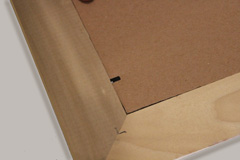
Picture frame back
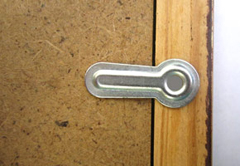
A turn button
|
| TYPES OF BACKING BOARDS
|
 |
|
Depending on your requirements and the size of your picture frame, there are various backing board materials that may be used.
- Foam Board (Foam Core)
The type of board we use most often in picture framing, foam board is made by sandwiching a layer of styrofoam between two thin sheets of clay-coated paper, resulting in a light but rigid surface about 3/16" thick.
- Gatorboard
Essentially a strong foam board, gatorboard is made from dense styrofoam which has been pressed between two wood-veneer sheets. It provides a strong, protective backing for more sensitive artwork.
- Matboard
More commonly used for the window mat placed in front of the artwork, matboard works well as a backing board when archival products are needed. Although acid-free foam board is an option, 100% lignin-free, cotton matboard is museum-quality, quite thick, and will never discolor or degrade the artwork.
- Di-Bond
For an extra-strength backing board, di-bond may be used in place of a lighter material. An aluminium composite with a polyethylene core, di-bond is extremely durable and long-lasting. Because it is waterproof, it is often used as a backing for outdoor signage and displays.
- Sintra
Made from PVC plastic, this thin, rigid backing is not often used for picture framing but, like di-bond, can serve as an extra-strong protective back in cases where punctures or other damage are a concern. Like di-bond, Sintra is waterproof and ideal for outdoor signs and displays.
Note: Though cardboard, bristol board, and thin plywood are often used as backing in at-home picture framing projects, this is not recommended. The wood-based products are high in acid (called lignin) that causes fine art papers to yellow over time, and your images can begin to discolor in as little as a few months. Archival options like di-bond or matboard are not essential, but at minimum, a quality board such as acid-free foam board should be used for any framing jobs intended to last more than a couple of weeks.
For more information on all these products, see our Mounting Boards price calculator and info page.
|
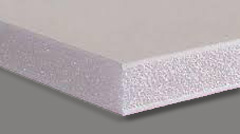
Foam board
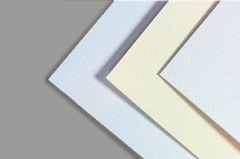
Matboard
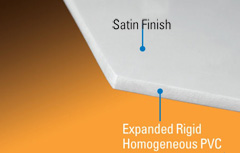
Sintra
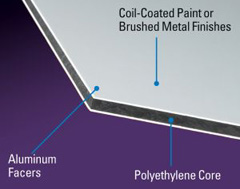
Di-bond
|
| OTHER USES: DRY MOUNTING
|
 |
|
The board options offered at KeenART Media are not available solely to serve as the backing to your framed artwork. Each of the materials described above can also be used as the base for dry mounting prints.
Dry mounting involves adhering a paper or canvas print to a rigid surface using a double-sided adhesive tissue. The tissue is placed between the board and the print, and the sandwiched materials are joined using a vacuum press, which applies heat - to soften the adhesive - and pressure - to hold the pieces together until they have adhered.
Dry mounting is preferable to using a glue or spray adhesive because the print is never wet. As a result, air bubbles, warping, and wrinkling are rare. The result of this process is a clean and contemporary, frameless display style, often hung on the wall using a recessed frame (for a floating appearance) or a simple hook.
Note: Original artwork can be dry mounted, but this is not recommended as the process is permanent and the artwork cannot be removed from the mounting board without being destroyed.
For more information, or to place your dry mounting order today, visit our Dry Mounting pricing and info page.
|
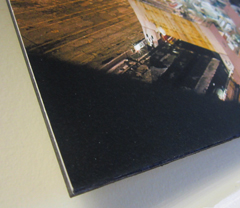
Matte print on di-bond
|
|
If you have questions about any of our services or products, don't hesitate to contact us. Our knowledgeable staff is always happy to assist with answers, advice, or suggestions.
|
|
© 2002-2025 - KeenART Media Ltd.
|
|
| |
|

